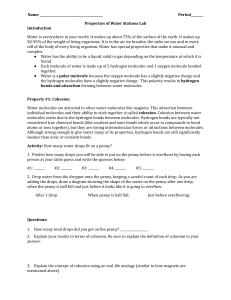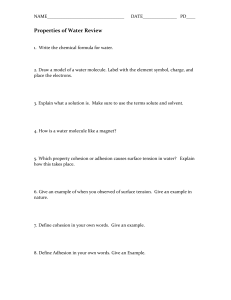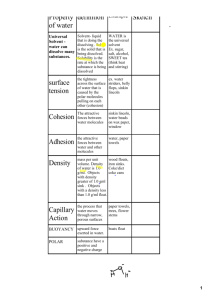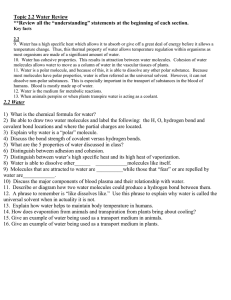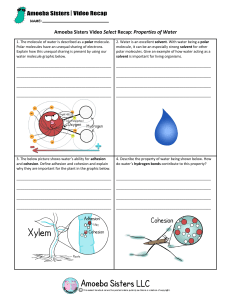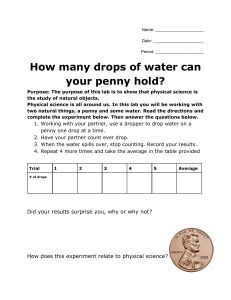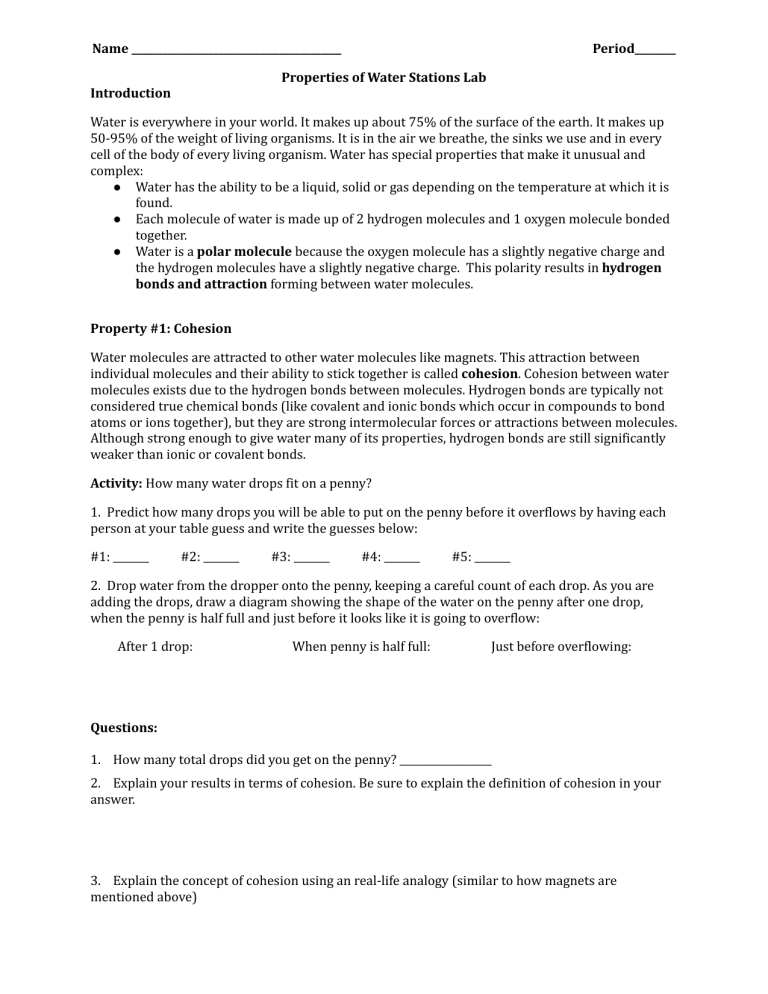
Name _________________________________________ Period________ Properties of Water Stations Lab Introduction Water is everywhere in your world. It makes up about 75% of the surface of the earth. It makes up 50-95% of the weight of living organisms. It is in the air we breathe, the sinks we use and in every cell of the body of every living organism. Water has special properties that make it unusual and complex: ● Water has the ability to be a liquid, solid or gas depending on the temperature at which it is found. ● Each molecule of water is made up of 2 hydrogen molecules and 1 oxygen molecule bonded together. ● Water is a polar molecule because the oxygen molecule has a slightly negative charge and the hydrogen molecules have a slightly negative charge. This polarity results in hydrogen bonds and attraction forming between water molecules. Property #1: Cohesion Water molecules are attracted to other water molecules like magnets. This attraction between individual molecules and their ability to stick together is called cohesion. Cohesion between water molecules exists due to the hydrogen bonds between molecules. Hydrogen bonds are typically not considered true chemical bonds (like covalent and ionic bonds which occur in compounds to bond atoms or ions together), but they are strong intermolecular forces or attractions between molecules. Although strong enough to give water many of its properties, hydrogen bonds are still significantly weaker than ionic or covalent bonds. Activity: How many water drops fit on a penny? 1. Predict how many drops you will be able to put on the penny before it overflows by having each person at your table guess and write the guesses below: #1: _______ #2: _______ #3: _______ #4: _______ #5: _______ 2. Drop water from the dropper onto the penny, keeping a careful count of each drop. As you are adding the drops, draw a diagram showing the shape of the water on the penny after one drop, when the penny is half full and just before it looks like it is going to overflow: After 1 drop: When penny is half full: Just before overflowing: Questions: 1. How many total drops did you get on the penny? __________________ 2. Explain your results in terms of cohesion. Be sure to explain the definition of cohesion in your answer. 3. Explain the concept of cohesion using an real-life analogy (similar to how magnets are mentioned above) Property #2 – Surface Tension Related to cohesion is surface tension, a measure of how difficult it is to stretch or break the surface of a liquid. Surface tension is also described as the tendency of a liquid to minimize surface area. Water has a particularly high surface tension due to the hydrogen bonds. Because the water molecules at the surface have water molecules pulling on them/attracting them from the bottom only, not the top, they pack very closely together. This close packing is what allows an insect to walk on water or you to skip a rock across a pond. In the previous activity, surface tension was evident in the dome shape of the water on the penny. The molecules formed a dome to minimize surface area. In this activity, you will compare your results from the previous activity to results of the same procedure using a penny coated with detergent. The addition of detergent will change the surface tension property of the water. Activity: 1. Predict how many drops you think this penny will hold of the soapy water. #1: _______ #2: _______ #3: _______ #4: _______ #5: _______ 2. Drop water from the dropper onto the penny, keeping a careful count of each drop. As you are adding the drops, draw a diagram showing the shape of the water on the penny after one drop, when the penny is half full and just before it looks like it is going to overflow: After 1 drop: When penny is half full: Just before overflowing: 3. Did the soap have an effect on the outcome? Explain your results compared to your results in the first activity. 4. How does the soap affect the water? (Look back at the definition and cause of surface tension) What do you think the detergent affects? Property #3 - Universal Solvent Because of its high polarity and thus ability to attract ions and other polar substances, water is called the universal solvent. A solvent is a substance that dissolves, or breaks apart, another substance (known as a solute). A general rule that determines whether a substance will dissolve in a solvent depends upon its polarity. Polar solvents, like water, dissolve polar or ionic solutes and nonpolar solvents dissolve nonpolar solutes. Water’s ability to dissolve many solutes and as the main solvent found in living organisms, makes water’s property as a solvent vital to life. Activity To observe how water behaves as a solvent, you will attempt to dissolve a variety of substances in liquid water. To do so, measure 50 ml of deionized water into each of four 100 ml beakers and attempt to dissolve each substance by thoroughly stirring or swirling. Record the results in the data table, noting whether each substance is polar, non-polar or ionic: Beaker #1 – 0.5 grams of NaCl, also known as “table salt” (ionic) Beaker #2 – 0.5 grams of sucrose, also known as “table sugar” (polar) Beaker #3 – 1 squeeze from a transfer pipet of vegetable oil (non-polar) Substance Name Polar, Non-Polar or Ionic Did it dissolve in water? Questions: 1. Why is water called the universal solvent? 2. What types of substances dissolve in polar solvents like water? What types of substances do not dissolve in polar solvents? 3. Which substance(s) did not dissolve completely in water? Why? 4. Compare and contrast terms polar and non-polar. You may use notes from earlier in the unit. Property #4 – Density in solid water vs. liquid Density is a measure of the mass per unit volume of a substance, but can also be described by how compact or tightly packed the particles of a substance are in a given volume. Density increases if the number of particles in a given volume is higher and decreases if the number of particles in the same volume decreases. Thus, most solids are more dense than liquids of the same substance because the particles are more closely packed together. 1. How is the density of liquid vs. solid water different from most substances? 2. Draw a particle diagram to show the difference between water at the solid, liquid and gas states. (Think about your previous knowledge of solids, liquids and gases to draw the diagram.) 3. Why are the diagrams for water (between solid and liquid) different from what you would see for most substances? Explain using water’s chemical properties. 3. What happens when you place an ice cube in water? Does it sink or float? 4. Explain why this property is important to aquatic organisms. Why would they not survive if water did not have this property?
